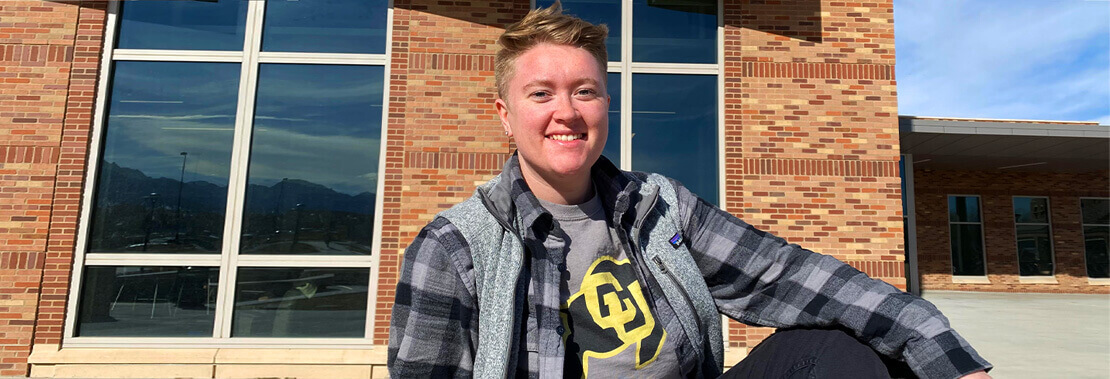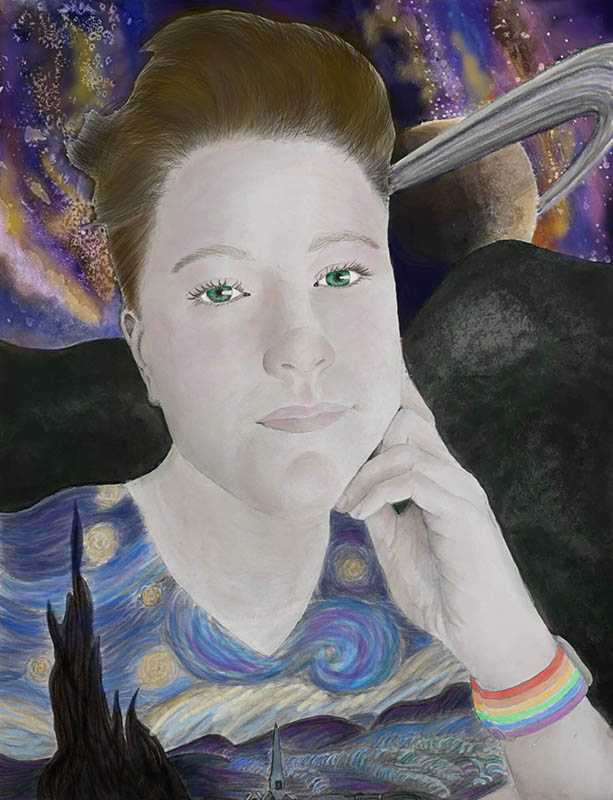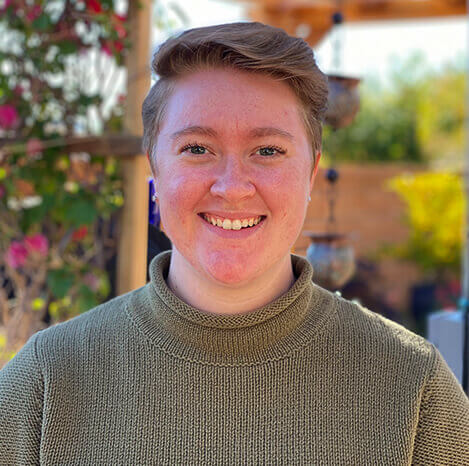
The Sky’s the Limit
A prestigious fellowship propels a Pima Community College graduate toward an enriching career in aerospace engineering. Pima instructors helped set her on course
Liza Graybill is embarking on a career that one day could reach the stars after getting a boost of encouragement from Pima Community College instructors.
Graybill, 24, received an associate degree in Science with a Pre-Engineering Concentration from Pima in May 2021 before transferring to one of the top engineering schools in the nation, the University of Colorado-Boulder, where she is majoring in Aerospace Engineering.
Aerospace Engineering is wide-ranging discipline that is concerned with the design, development, testing, and production of aircraft, spacecraft and related systems and equipment. The field has two branches:
- Aeronautical Engineering focuses on flight within the earth’s atmosphere.
- Astronautical Engineering focuses on spacecraft and launch vehicles.
In general, qualified engineers in aerospace and other disciplines can make six-figure salaries with just a bachelor’s degree, according the Bureau of Labor Statistics.

Recently, Graybill was named one of only 51 college students nationwide to be earn a Brooke Owens Fellowship, which recognizes “exceptional undergraduate women and other gender minorities with space and aviation internships, senior mentorship, and a lifelong professional network.” [Graybill says Pima Math instructor Jennifer Guajardo played a “crucial role” in the fellowship process by writing a letter of recommendation attesting to her academic abilities.]
An “amazing” instructor
It’s an impressive résumé, especially considering that as a high school student in Lititz, Pa., a town of about 10,000 located west of Philadelphia, “engineering was not really an option that was on my mind,” Graybill says.
After her family moved to Tucson, Graybill began taking classes at Pima’s Northwest Campus. That’s where she met an “amazing” instructor, Mary Minke of Pima’s Math faculty.
“[Dr. Minke] said that I should try Engineering,” Graybill said. “It was kind of like ‘Huh -- that’s a possibility.’ I’d forgotten that that was an option.” Dr. Minke also wrote a letter of recommendation in support of her application to CU-Boulder.
Taking “baby steps” in Engineering
Dr. Minke said she first noticed Graybill’s abilities during group work sessions in her MAT 212 Topics in Calculus class. “Liza quickly emerged as a leader,” Dr. Minke said. “In addition, during class she would ask questions that involved a deeper level of understanding of the mathematical concepts.”
Graybill had briefly attended an aeronautical university. “I realized that she had had a bad experience [at the school] and because of that thought Engineering was not for her. I encouraged her to rethink that decision and to follow her dream of Aerospace Engineering with baby steps at Pima.”
Dr. Minke also recommended her as a tutor for MAT 212 to introduce her to other Engineering students. Tutoring allowed Graybill to see that she was a good fit for Engineering, Dr. Minke said, adding, “I am excited to see what Liza will do in the future!”
Graybill has never doubted her academic and career choice since choosing engineering. “Engineering is a cool discipline. I’ve always wanted to do something that was cutting edge. … something that didn’t have all the answers.”
“An incredible environment”
Yet another faculty member, Art instructor Mariana Carreras, encouraged Graybill to explore her creative side while taking a Pima art class. Graybill credits Ms. Carreras with creating “an incredible environment for self-expression and support” that allowed her to put as much of herself as possible into the semester’s final, space-themed self-portrait, which Graybill reimagined as part of her application for the Brooke Owens Fellowship. [The self-portrait was featured during the “Lockdown Year” exhibit at the Art Gallery @ Downtown Campus.]
The self-portrait involved working 1-on-1 with Ms. Carreras as Graybill experimented with various techniques, including stippling and using salt in the process. The creation of the background was an added level of challenge for Graybill as it involved some unpredictability while combining water, salt, and ink to achieve the galaxy-like appearance.
The original design and final self-portrait are entirely in black and white. Ms. Carreras had asked about during the initial stages of the design process about the choice to not use color. Ultimately, Graybill felt that the use of only black and white showed a greater degree of transparency and vulnerability between the image of herself and the viewer.
Says Ms. Carreras, “Some great visual artists are engineers – visual thinkers.” She praised Graybill’s “observant nature, and her ability to break down an incredibly complex topic into steps that she pulled together for the final project.”
“I am super-proud of her.”
Expressing herself through color
The Brooke Owens Fellowship application required an original creative piece “original works, created by you specifically for this application,” and the prompt: “What else do we need to know about you?”
Graybill knew instantly that this portrait had to be included but still needed to create something specifically for the application. “This portrait had so many elements of myself, beyond my face, that I couldn’t imagine a better way to show the review committee who I am outside of academics.” The solution: reimagine the portrait by taking the leap into color, which she accomplished through an art app on her iPad.
The creative piece did not end there. To fully create something specific for the application, Graybill recorded a five-minute video that showed the reimagined portrait in color and detailed the most important components, feelings, and thoughts that were poured into its creation. In the video, Graybill describes the parallels to future career aspirations with the desire to pursue and explore the unknown in space.
“Mariana’s support during the creation of the final self-portrait allowed me to create something so self-expressive that it felt perfect to include as a part of this fellowship,” Graybill said. “Nothing else is as descriptive of who I am as that portrait is. It takes a wonderful art professor to create an environment that’s capable of allowing for that level of creation.”
Q and A
Lightly edited for clarity
How did a Pima education help you in your current studies?
Pima gave me all my foundational courses – my Math courses, my Physics courses. Pima gave me the concepts to take the next step forward.
Why the University of Colorado-Boulder?
This program at CU-Boulder is in the top 10 in the country. I couldn’t pass up the opportunity of studying here when I got my acceptance letter. What drives my passion in studying aerospace engineering is being inspired by those around me. The faculty in this aerospace department have done, and are currently doing, research that does just that: it inspires me. Their connections reach quite far, and I have a lot to learn from them. This faculty also includes an astronaut as a Scholar in Residence. [James Voss, who teaches an elective course on spaceflight.] Lockheed Martin is also in Colorado and we’re surrounded by numerous aerospace companies and start-ups. Colorado alumni stretch to every corner of the industry.
How was the transition, transferring from Pima to a top-flight engineering school?
The transition was a little difficult to start, but something to consider is that we’re all coming out of a pandemic year of online learning. Because I was transferring to a university and program out of state, transfer credits do not apply as directly as they do if I had chosen a university in Arizona. Pima and the other Arizona community colleges have pathway agreements and programs to make that transition as seamless as possible. I had to take a more active role in this process and advocate for myself to make sure I got the most out of my credits. Working with pre-transfer advisors discussing my credits and then eventually my academic advisor was an integral part of that process as well.
The transition process also varies widely depending on the degree you’re pursuing. The rigor of the department I transferred to is extensive, and I had been properly warned ahead of time by my advisor about the workload of the aerospace curriculum. It was a step up in difficulty level for sure and that took quite a bit of adjusting, but the material I learned at Pima still serves as a solid foundation.

In the end, the transition and transfer experience are what you make of them. Finding your group of people, finding friends, and creating a supportive network is crucial, especially if you are transferring to a university in a different state. Be prepared to reenter that awkward phase of making new friends in a new environment.
Do your research ahead of time. Check out the programs available to you and use them! Universities usually have additional resources for transfer students that help smooth that transition into university life. Those resources and events will also connect you with other transfer students.
You’ve made it to the point where you’re ready to transfer. Be confident and happy with your decision because that makes a world of a difference in mindset. Seek out advice of those around you and embrace the next step in your education.
More women are embracing STEM careers. What’s been your experience as a woman in what has been primarily a male field?
Women and gender minorities in general are underrepresented in aerospace engineering. Since this is a primarily male field, being a woman in STEM can be challenging. Finding a group of women in STEM to boost each other up is key. The fellowship is a way to increase this community by bringing women and gender minorities together and incorporating the fellows into a network that will set them up for success entering this male-dominated industry.
Talk more about the fellowship.
The fellowship has an incredible reputation within the aerospace community. It opens networking to an incredible degree. As part of the fellowship, we get two mentors, one working in the aerospace community as a senior leader and one is an alum from the fellowship. The mentoring pool consists of over seventy mentors, and the caliber of these mentors puts the fellows of the program in an amazing position for success and guidance in this industry. One Brooke Owens mentor has just been appointed as the first female director of the Jet Propulsion Lab. [Another is] Emily Calandrelli, who has a Netflix science show.
When are you on track to graduate from CU-Boulder?
- I’ve added an extra year.
Why?
[Laughs] Because Thermodynamics is hard to pass. Honestly, though, if I’ve learned anything from my path and journey to this point, it’s that I have to navigate at my own pace. All my lower-division and free credits were fulfilled by Pima, and I’d like to have the space to explore a minor while at CU-Boulder. It just wasn’t logistically feasible with the heavy course load. Adding a year gives me the extra space to explore more classes outside of my program and creates room for a healthier and more sustainable balance between school and life.
What would you like to focus on as an aerospace engineer?
I’m interested in the space exploration part. I would like to contribute to the navigational aspects of space missions by writing software. It’s coding and software that makes things happen.
Do you ever think about going into space?
I would love to go into space.
See More Stories
Explore your Career Opportunities at Pima
Want to explore career paths but not sure where to start? Take advantage of Pima’s resources to identify and gain insight into your interests, skills, values, personality and other factors that help you choose a major and set career goals.
Ready to start your career path at Pima? Apply Now